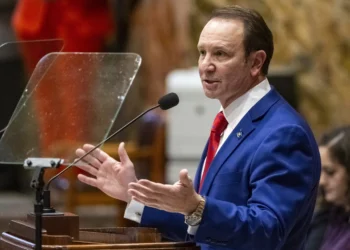Republican Rutherford B. Hayes squared off against Democrat Samuel J. Tilden — with Greenback Party candidate Peter Cooper receiving over 75,000 votes — but the election outcome was uncertain.
How is that possible? On Election Day, Tilden seemed poised to win, as he was in the lead with more than 250,000 votes, but not all the votes were in. Three states — Florida, Louisiana, and South Carolina with their 19 electoral votes — had not be called. Hayes’s friend and political adviser, William E. Chandler, ran the numbers and realized that if Hayes took the three states and Oregon, originally called for Tilden but then in question, he could win the electoral vote.
By December, when the electors met to cast their votes, the final count remained uncertain. The vote seemed to change almost daily and, for six weeks, both candidates experienced moments of hopeful anticipation countered by the darkness of uncertainty. Finally, on January 29, 1877, Congress created an Electoral Commission to determine how to break the deadlock. The 15-member bipartisan commission — five House members, five Senators, and five members of the U.S. Supreme Court — met and began entertaining possible compromise protocols. In the meantime, Hayes’s allies in the Republican Party reached out to moderate Southern Democrats with a possible compromise that would result in positive outcomes for both factions. When the vote was counted at 4 AM on March 2, Hayes was declared the winner with a 185-184 final electoral vote and secretly took office by oath the following day with a formal, public ceremony two days later.
The outcry from the Democratic Party was loud and shrill, dubbing Hayes as “Mr. Fraudulency.” However, the Southern Democrats seemed mildly accepting of the decision and quite pleased when days later President Hayes announced a planned withdrawal of military forces occupying the South. Reconstruction was complete, and the Southern states reunited in a political block that would become known as the “Solid South.”
Hayes moved forward quickly with his plans for the end of Reconstruction, but he found himself in a difficult position. He had announced the withdrawal of military occupying forces in the Southern States, but that position was in direct opposition to his previous positions.
As a member of the House, Hayes had supported the Radical Republicans’ plans for the South, including universal male suffrage. As governor of Ohio, Hayes had spoken out in favor of the 15th Amendment, which eliminated race as a barrier for voting. Now, without military enforcement of voting rights in the South, the pendulum swung backwards to prewar conditions. Between a heightened emphasis on race and violent threats toward black citizens who attempted to vote — often at the hands of the Klu Klux Klan — the Southern Democrats steadily gained control in the South. Within weeks, only South Carolina and Louisiana remained in the hands of Republicans, and those two states would quickly become hotbeds of racial inequality as whiplash politics became the model.
Hayes realized that the final removal of troops would allow the South to reinforce old systems with new names and that any hope for a reconciliation that would result in an “all men are created equal” government was evaporating quickly.
But what was he to do?
The majority of the U.S. Army had been posted to the West to deal with Indian uprisings and to protect settlers moving into new territories. The House, controlled by the Democrats, showed no inclination to help the president politically or financially by appropriating funds for monitoring activities in the South. Truthfully, many Northerners were struggling with the economic recession sweeping across the nation and appeared to have lost all heart for bringing the South into compliance. Hayes realized he was standing alone in a battle that had already been lost.
From 1877 until the turn of the 20th century, the South threw off any vestiges of racial equality. While the 13th, 14th, and 15th Amendments had become constitutional law, the Southern Democrat leaders systematically created a climate that denied those very rights, including suffrage. Poll taxes, grandfather clauses, literacy tests, threats of violence, and violence itself rendered most blacks helpless in their fight for equality. Even more frightening, the federal government was absent from the fight even though Hayes attempted to use his “veto” voice to assist Southern blacks. In the end, the promises voiced with the Emancipation Proclamation and the Civil War amendments seemed hollow for decades.
Hayes was tormented by the result of the compromise that had guaranteed him a presidential victory. His only hope was to make progress in other areas.

















